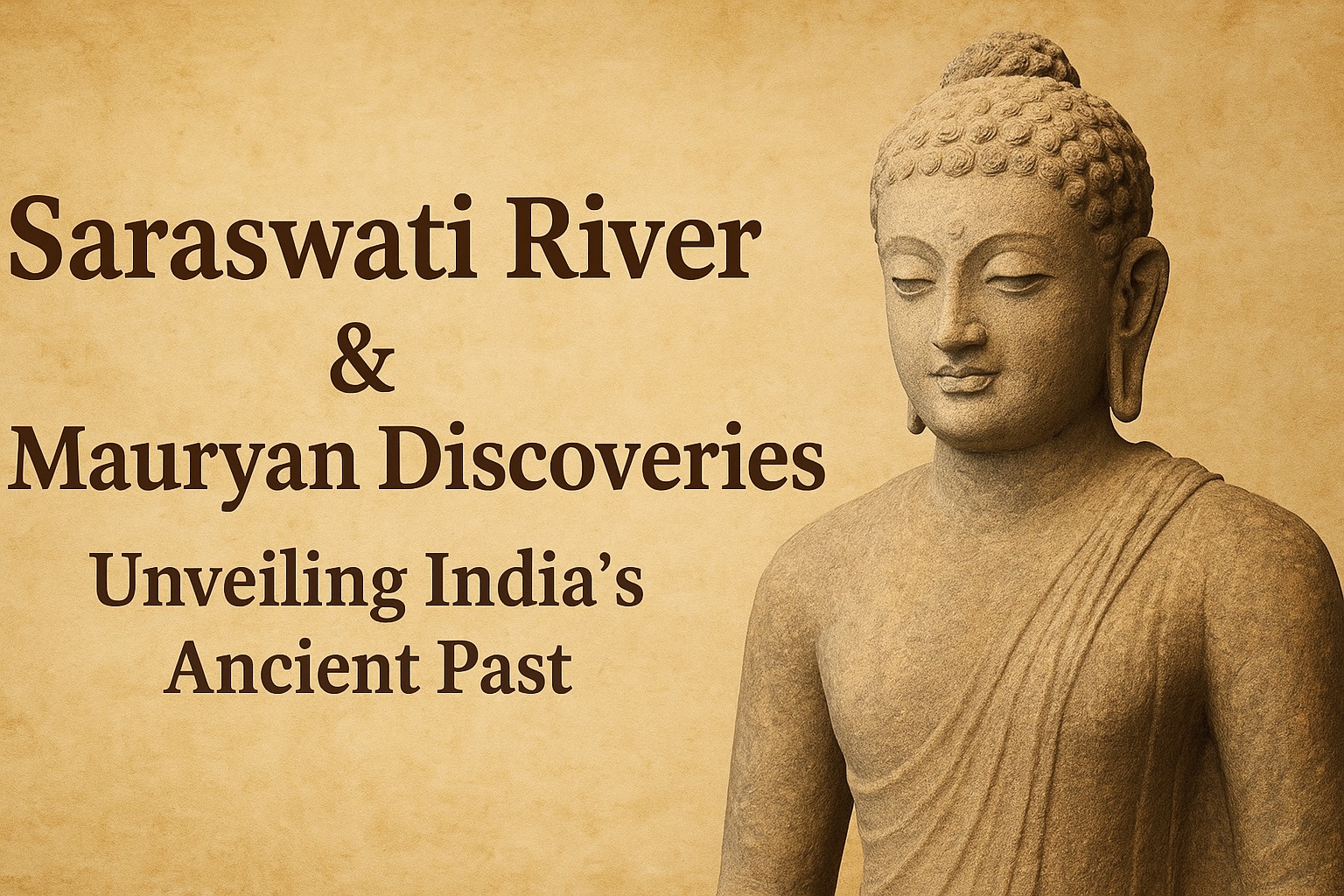Saraswati River and Mauryan Discoveries -Discover the mysteries of the Saraswati River and archaeological findings of the Mauryan Empire. A deep insight into ancient Indian civilization.
For official details: Archaeological Survey of India
Introduction
India’s ancient history is filled with legends, lost civilizations, and fascinating discoveries. Among these, the mystery of the Saraswati River and the archaeological remains of the Mauryan Empire hold special importance. For centuries, the Saraswati River was considered mythical, mentioned in the Vedas, while the Mauryan dynasty (321–185 BCE) was India’s first great imperial power.
This article explores the archaeological evidence of the Saraswati River, the grandeur of the Mauryan Empire, and how modern research is rewriting ancient Indian history.
The Saraswati River in Vedic Literature-Saraswati River and Mauryan Discoveries
References in the Rigveda
- The Rigveda, India’s oldest scripture, describes the Saraswati as the “greatest of rivers”.
- It is said to have flowed between the Yamuna and Sutlej rivers, nourishing the land of the Vedic people.
Decline and Disappearance
- Geological studies suggest the river began to dry up around 2000 BCE due to tectonic shifts and climate change.
- By the late Vedic age, it became seasonal, eventually vanishing into the Thar Desert.
Modern Archaeological Evidence of the Saraswati River-Saraswati River and Mauryan Discoveries
Satellite Imaging
- ISRO and international agencies used satellite images to trace a paleochannel (dry riverbed) across Haryana, Rajasthan, and Gujarat.
Discoveries in Rajasthan
- In 2025, the Archaeological Survey of India (ASI) found an ancient river channel in Bharatpur, Rajasthan, believed to be part of the Saraswati.
- Pottery, settlements, and irrigation systems were found along this river course.
Harappan Civilization Link
- Many Indus Valley sites (Kalibangan, Banawali, Rakhigarhi) are located along the dry bed of Saraswati.
- This proves that the Harappan civilization was not limited to the Indus, but also flourished along the Saraswati.
The Mauryan Empire: Foundation of Indian Unity-Saraswati River and Mauryan Discoveries
Rise of the Mauryas
- Founded in 321 BCE by Chandragupta Maurya after overthrowing the Nanda dynasty.
- Guided by his mentor Chanakya (Kautilya), the author of Arthashastra.
Expansion under Ashoka
- Emperor Ashoka the Great (268–232 BCE) expanded the empire across almost the entire subcontinent.
- After the Kalinga War, Ashoka embraced Buddhism and spread its teachings across Asia.
Administration and Economy
- Highly organized bureaucracy, centralized taxation system, and road networks.
- Use of Mauryan punch-marked coins – many with elephant and sun symbols – found in excavations.
Archaeological Discoveries Related to the Mauryan Period-Saraswati River and Mauryan Discoveries
Inscriptions and Edicts
- Ashokan Rock and Pillar Edicts found across India – Girnar (Gujarat), Sarnath (UP), Dhauli (Odisha).
- Written in Brahmi and Kharosthi scripts, promoting dhamma, tolerance, and welfare.
Architecture
- Remains of Pataliputra (modern Patna) show wooden palisades and stone structures.
- Barabar Caves in Bihar – earliest rock-cut caves, used by Ajivika monks, polished to perfection.
Coinage
- Mauryan coins with motifs like elephants, sun, and geometric patterns.
- Excavated from sites in Uttar Pradesh, Bihar, and Madhya Pradesh.
Saraswati and Mauryas: Cultural Significance-Saraswati River and Mauryan Discoveries
Though separated by time, the Saraswati River and the Mauryan Empire symbolize two phases of Indian civilization:
- Saraswati – the cradle of Vedic and Harappan cultures.
- Mauryas – the political unification of India under a central empire.
Both represent India’s continuous heritage of spirituality, knowledge, and governance.
Global Impact of Discoveries
- Saraswati findings challenge earlier colonial theories that India’s civilization was only “Indus-based.”
- Mauryan legacy shows how India influenced Southeast Asia through trade, art, and Buddhism.
Conclusion
Saraswati River and Mauryan Discoveries -The rediscovery of the Saraswati River’s ancient channel and the archaeological remains of the Mauryan Empire reveal that India’s history is far older and richer than once believed. While Saraswati represents India’s spiritual and cultural origins, the Mauryas symbolize political strength and administrative brilliance.
Together, they remind us that India’s civilization is a blend of continuity, adaptation, and innovation — a heritage still influencing the world today.
“This proves that the Harappan civilization was not limited to the Indus, but also flourished along the Saraswati. You can read more detailed research-based articles on Indian history at Smart Bharat Manch.

